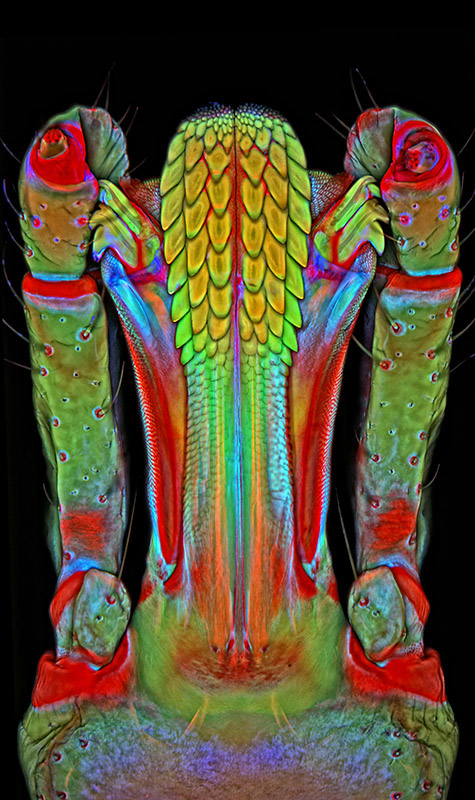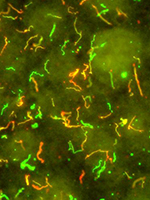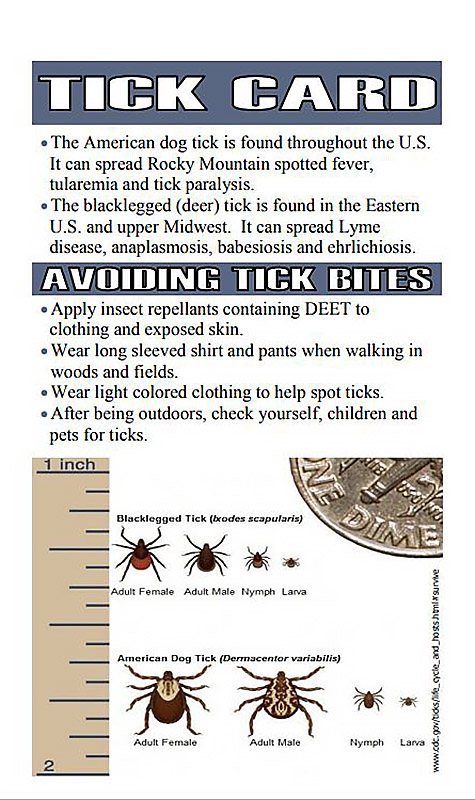08 Nov UND microbiologist Catherine Brissette explores the mysteries of Lyme disease
Although the deer tick is responsible for the spread of Lyme disease in North America, University of North Dakota microbiologist Catherine Brissette says it’s not the only reason to be concerned about the tiny insects that latch on to people, mammals and birds to feed on their blood.
During a recent presentation to the North Dakota Environmental Health Association, Brissette – an associate professor of biomedical sciences – discussed the impacts of Lyme disease on the state. She noted that research conducted by UND biologist Jeff Vaughan shows that in eastern North Dakota, the number of ticks and small rodents testing positive for Lyme disease has increased from 6 percent to about 30 percent within a few years.
“In North Dakota, we’ve gone from a handful of Lyme disease cases in the early 2000s to 56 cases in 2017,” Brissette said. “It doesn’t sound like very much, but the CDC (Centers for Disease Control) has done studies indicating that the disease could be underreported by 10-fold. There’s probably a lot more of it that we’re just not catching.”
That’s partly because people either don’t know they’ve been bitten by an infected tick, mistake Lyme disease for the flu or don’t display the classic symptoms associated with the disease. And sometimes it takes weeks for signs of Lyme disease to show up in blood tests.
Tick-borne diseases spreading

This photo of a tick’s mouth shows why it’s difficult to remove a feeding tick. The center of the mouth (yellow) is covered in tiny barbs that help keep the tick lodged on the host. Photo by Igor Siwanowicz, Janelia Farm Research Campus, Howard Hughes Medical Institute.
In addition, Brissette pointed out that ticks carry other diseases of concern to humans besides Lyme disease. A plan to address the problem released last month by the National Institutes of Health (NIH) Tick-Borne Diseases Strategic Planning Team said the number of cases of tick-borne diseases in the U.S. more than doubled between 2004 and 2016 to a record high of 59,349. The NIH researchers listed 14 other diseases besides Lyme disease carried by ticks – some of them deadly to humans.
In the UND lab where Brissette serves as the principle investigator, her team’s primary focus is on the Borrelia burgdorferi bacteria that causes Lyme disease. It’s transferred from the black-legged deer tick to the host animal. A refrigerator in the lab called “The Tickary” houses the infected ticks studied by researchers. The ticks live inside sealed tubes stored in plastic cases.
“I’m really interested in understanding how the bacteria do what they do to us. What makes them tick?” Brissette said – with no pun intended. “All of my research is focused on the interface between the bacteria and the host – us. What happens when they first meet? How do our bodies respond to the bacteria, and how do our bodies try to counteract that?
“There’s just so much we don’t understand,” she added. “As a scientist, I like solving puzzles when there are a lot of unanswered questions.”
Lyme disease symptoms include headaches, a stiff neck, a rash, joint pain and swelling, shooting pains and numbness or tingling in the hands and feet. It can also cause neurological symptoms, such as swelling of the brain or spinal cord.
An old disease
The disease is named after the town of Lyme, Conn., after an outbreak was discovered there in the 1970s. Brissette said Lyme disease also occurs in temperate areas of northern Europe and Asia. It was even detected in the 5,300-year-old Iceman mummy discovered in the Alps of Italy in 1991.
“Borrelia burgdorferi doesn’t want to kill you, it just wants to survive,” Brissette said. “A lot the disease manifestations in people are really about the body overreacting to the bacteria. I find that really fascinating.”
Another aspect of the bacteria that Brissette finds compelling from a microbiology perspective is that it undergoes a two-stage life cycle.
“It’s in ticks, and then it’s in mammals, birds, mice and sometimes people,” she said. “The bacteria must adapt to two entirely different environments. Being in a cold-blooded tick is much different from being in a warm-blooded person.”

UND microbiologist Catherine Brissette is the principle investigator in a lab seeking answers to questions about the Borrelia burgdorferi bacteria that causes Lyme disease. Photo by Patrick C. Miller/UND Today.
If the disease is detected early and treated with antibiotics, it can often be cured. However, when that doesn’t happen, Brissette said effectively treating Lyme disease can be difficult. Some people continue to experience arthritis-like symptoms even after the bacteria has been eliminated.
“We don’t know why that happens for some patients,” she said. “There’s evidence that even after the bacteria’s been killed, you can have bacterial junk that doesn’t get cleared by your immune system. It hangs out in your joints and can perpetuate a continued immune response – similar to an autoimmune disease.”
Neurological questions

Borrelia burgdorferi bacteria
Brissette said another area of her research focuses on the neurological manifestations of Lyme disease.
“We don’t know a lot about why some people might be susceptible to neurological symptoms,” she said. “None of this happens in a vacuum. Is someone more likely to have the neurological manifestation if they have a co-infection or if they’ve been exposed to a toxin in the environment? Do they have genetic factors that predispose them? Those are some big unanswered questions.”
Brissette’s lab is also studying the use of laboratory mice as a potential model that will enable researchers to more closely examine infections of the brain and spinal cord.

This image from the North Dakota Department of Health shows the difference between the American dog tick commonly found in the state and the black-legged deer tick, a carrier of the bacteria causing Lyme disease.
“One of the big problems in studying the neurological manifestations of Lyme disease has been lack of a small-animal model that we can use to drill down to look at the mechanism,” she noted. “If we had a model to manipulate, then we can ask: How does this happen? Why does it happen? How can we intervene?”
Ultimately, Brissette would like to see her lab’s research lead to the development of a treatment for post-treatment Lyme disease syndrome.
“We’d like to get to a point where we can test various treatments. That’s a major focus of our research right now,” she said.
An ounce of prevention
In North Dakota, black-legged deer ticks spread Lyme disease. The far more common dog tick, also known as the wood tick, does not. Ticks prefer cool, wet, wooded areas. Deer ticks are more likely to be found in larger wooded areas, according to Brissette.
“The adult ticks tend to feed on larger animals like deer,” she explained. “Deer are important because they’re where the adult ticks meet and mate. That’s how the ticks get perpetuated. Deer don’t seem to get sick or acquire the infection, but they play an important role in the cycle.”
Prevention is the best way to avoid getting Lyme disease, Brissette said. Before entering an environment where ticks could be prevalent, she advised using an insect repellent containing DEET. Also, wear long, light colored pants because ticks are easier to spot on them. If possible, wear pants tucked into boots.
“If you’ve been out in an area where you’re worried about ticks, do a tick check every day,” Brissette suggested. “Take a shower and check your skin. It takes a while for the tick to transmit the bacteria. They feed for a long time – three to five days. It can take more than 24 hours to transmit the bacteria. The faster you remove a tick, the less likely you are to get Lyme disease.”
UND seed funding
Most of the research in Brissette’s lab is funded by NIH, but the lab also has received funding from foundations and not-for-profit organizations, such as the Global Lyme Alliance. Brissette is a member of the group’s scientific advisory board.
She said that while federal research funding has been tight for several years, $60,000 in seed funding during FY18 from the UND Vice President for Research & Economic Development Office has helped. The office has awarded $6 million in seed money to faculty for FY17-19.
Brissette and two of her colleagues in biomedical sciences – Archana Dhasarathy, associate professor, and Junguk Hur, assistant professor – submitted a proposal resulting in the hiring of Atrayee Ray, a postdoctoral researcher. They’re all part of a cross-disciplinary project studying processes that occur when cells transition and become metastatic – moving to places they shouldn’t be – which could apply not only to Lyme disease-related arthritis but also to cancer.
“This is a really great program because we’re somewhat geographically isolated, and we need to be able to attract talent to the University,” Brissette said. “Postdocs are really important for moving our research forward. Bringing that kind of research talent to UND is really helpful.”


